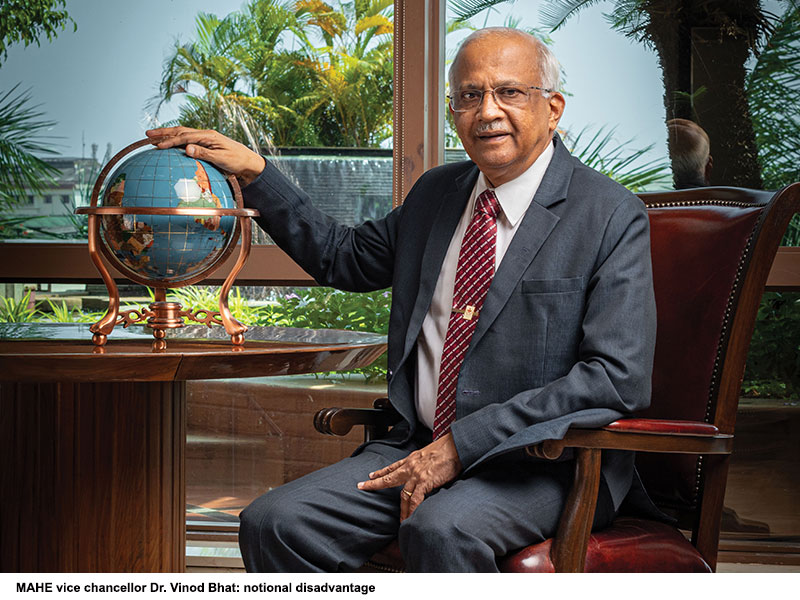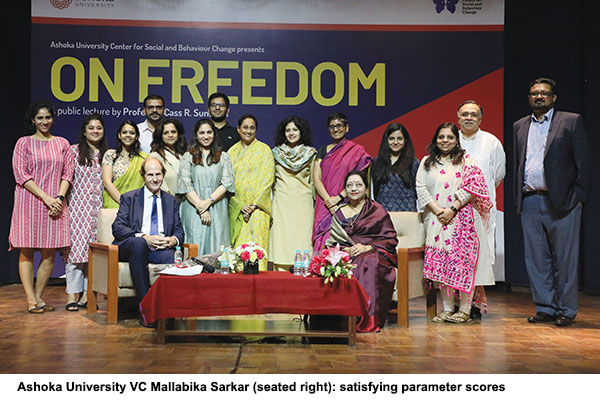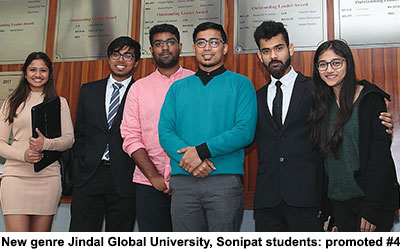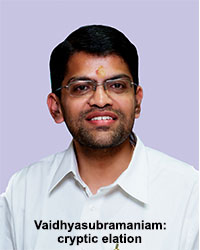Ab initio, your editors have accorded special importance to private institutions of higher learning. We believe private universities with investment and reputations to lose, are more likely to provide rigorous, globally benchmarked academic, research and life skills education
 In recent years privately promoted universities, particularly new genre, globally benchmarked liberal arts and sciences undergrad colleges modelled on America’s famous Ivy League institutions, have captured the imagination of the country’s aspirational post-liberalisation middle and upper class. The steadily rising number of unemployed graduates holding devalued degrees of government — especially state government — universities notorious for their crumbling infrastructure and obsolete syllabuses and curriculums, has created acute awareness of the value of real rather than ritual education dispensed by the majority of government institutions of higher education tightly controlled by generalist bureaucrats out of touch with the requirements of Indian industry and business.
In recent years privately promoted universities, particularly new genre, globally benchmarked liberal arts and sciences undergrad colleges modelled on America’s famous Ivy League institutions, have captured the imagination of the country’s aspirational post-liberalisation middle and upper class. The steadily rising number of unemployed graduates holding devalued degrees of government — especially state government — universities notorious for their crumbling infrastructure and obsolete syllabuses and curriculums, has created acute awareness of the value of real rather than ritual education dispensed by the majority of government institutions of higher education tightly controlled by generalist bureaucrats out of touch with the requirements of Indian industry and business.
Therefore ever since EducationWorld (estb. 1999) started publishing its annual EW India Higher Education Rankings in 2013, your editors have accorded special importance to private institutions of higher learning. We believe that academically and financially autonomous standalone privately-promoted higher education institutions with investment and reputations to lose, are more likely to provide rigorous, globally benchmarked academic, research and life skills education.
This not to say that your editors are indifferent to government colleges and universities. Some public higher ed institutions promoted at taxpayers’ expense by the Central and state governments also make a substantial contribution to national progress and development. However they are hamstrung by numerous social and community goals that tend to dilute their academic excellence objective. Therefore to avoid apples and oranges type comparisons, we believe that the public interest — and the interest of parents and school-leaving students in particular — would be better served if public and private institutions of education are ranked separately. This is the distinction we make in our annual EducationWorld India School Rankings — the world’s largest and most comprehensive schools annual survey — published every September.
Now after several years of chopping and changing, we have resolved to follow a similar path while rating and ranking India’s most respected institutions of higher learning. Last month (April) we published league tables ranking India’s most respected private autonomous, government autonomous, Top 100 non autonomous and Top 100 private engineering colleges. In this issue we present discrete league tables ranking the country’s Top 150 most reputed private universities, Top 150 government universities and Top 100 B-schools.
To conduct the EW India Private University Rankings 2020-21 survey, over 150 field personnel of the highly-reputed Delhi-based market research and opinion polls company Centre for Forecasting & Research Pvt. Ltd (C fore, stb.2000), interviewed 4,168 sample respondents comprising 2,214 faculty and 1,126 final year students of 162 universities, and 828 industry representatives in 25 cities countrywide.
They were requested to award private universities they are familiar with, scores of 1-300 on ten parameters of higher education excellence, viz, faculty competence faculty welfare & development, research and innovation, curriculum and pedagogy, industry interface, placements, infrastructure, internationalism, leadership/governance and range and diversity of study programs offered. Higher weightage is given to the critical parameters of faculty competence (150), infrastructure (150), and research and innovation (300).
“This year’s rankings league tables are based on a mix of factual objective criteria and perceptions of knowledgeable sample respondents. Objective data has been culled from papers published by faculty in refereed journals, and number of citations was obtained from secondary sources including the Scopus index. Twenty percent weightage is given to publications and citations in refereed journals worldwide,” says Premchand Palety, founder CEO of C fore.
Against this backdrop, it’s a matter of surprise to some metropolitan monitors of India’s higher education sector that the Manipal Academy of Higher Education (MAHE, estb. 1953), a deemed university, is ranked the country’s #1 private varsity for the fifth year consecutively, followed by the Birla Institute of Science & Technology, Pilani (estb. 1964) ranked second for the fifth year.
Both these universities are situated in small towns — “out in the boondocks, far away from India’s academically happening metro cities” — in the words of a trendy top executive of a transnational education consultancy firm. Nevertheless this year’s 4,168 sample respondents have awarded MAHE top scores under the parameters of infrastructure, leadership and diversity of study programmes, and second highest under the high weightage parameter of research and innovation, ranking it India’s #1 private university by a comfortable margin.
Dr. H. Vinod Bhat, the unassuming vice chancellor who has played a major role in consolidating MAHE’s reputation as India’s most admired private university, is gratified this globally reputed institution, which has fought many battles in courts of law and in the corridors of power in Delhi to win its university status, is ranked #1 for the fifth year in succession. And far from accepting that its location off the beaten track is a disadvantage, he believes that it’s a plus point.
“The perceived geographical disadvantage of MAHE is notional. Our 25,000 students are from as many as 70 countries and from every state of the Indian Union. In our scenic campus spread over 600 acres, we offer state-of-the-art infrastructure and global connectivity, as indicated by our top score under the infrastructure parameter. Therefore we don’t experience any difficulty in attracting excellent faculty and foreign students,” says Bhat who modestly declined to comment on this top ranked university’s #1 ranking under the parameter of leadership and governance.
Although MAHE has built an international reputation as a professional education (medicine, engineering, pharmacology, business management, law etc) institution during its first 50-60 years (25 percent of medical practitioners in Malaysia are reportedly graduates of the university’s Kasturba Medical College), in recent years it has evolved into a full-fledged multidisciplinary university. “While we have full-fledged programmes in the health sciences and engineering, we are in the process of strengthening our humanities stream. A new campus in Bangalore with more niche programmes is in the offing and will reinforce our multidisciplinarity. We have also added several new units such as the departments of languages, geopolitics, and centres of humanities and Gandhian studies. All these additions and diversification have made us a much more rounded university than it was when the focus was entirely on professional education,” adds Bhat who is particularly pleased with MU’s second highest score under the parameter of research and innovation. “We are planning a transformational shift to mould our learning ecosystem and processes in ways that will permit us to experiment with education, research and internationalisation using next generation digitisation,”adds Bhat.

The seemingly effortless ease with which it has vaulted into the Top 5 of the authoritative annual EW league table of India’s most admired private universities, is perhaps more palpable in the pioneer crowd-funded Ashoka University (AU, estb. 2014) sited in Sonipat, Haryana in the Delhi National Capital Region. Ranked #9 in 2016-17, this wholly residential American Ivy league style liberal arts and science university zoomed up the charts to second rank last year. Although this year’s sample respondents have ranked it #3, AU has been awarded top scores under the critical parameters of competence of faculty, curriculum and pedagogy and internationalism.
“I am very pleased that Ashoka is ranked among India’s Top 3 private universities for the second year in succession. We are a relatively young institution, but determined to transform higher education in India by evolving into the finest liberal arts and sciences university of the country. Our globally recognised faculty comprises outstanding teachers — as acknowledged by your sample respondents — who are also conducting advanced research in some of the most pressing issues of our time. We also pride ourselves on the quality of our students, each one of whom is chosen through a rigorous and holistic selection process. We are proud that after graduation, most of them have been inducted into the best corporate and other organisations, and some of the best-ranked universities for further education. Ashoka’s rapid rise in public esteem is also attributable to the sustained backing and generous contributions from our 150-strong group of founders which makes us a unique institution funded by collective philanthropy. I am gratified that Ashoka’s progress towards academic excellence is being recognised by the world,” says Dr. Mallabika Sarkar the recently appointed vice chancellor of AU.
With MAHE/Manipal ranked #1 and Ashoka #3, the crowded Top 5 table is completed by BITS-Pilani which has retained its #2 ranking, Amity University, Noida, jointly ranked #3, the fast-track O.P. Jindal Global University, Sonipat, promoted to #4 (#6 in 2019-20) jointly with III-T Hyderabad (4) and the Dhirubhai Ambani Institute of Technology & Research, Ahmedabad at #5 (6) jointly with the Vellore Institute of Technology, Vellore (Tamil Nadu). The Top 10 league table is completed by SASTRA University, Thanjavur (Tamil Nadu) promoted to #6 (9), SRM, Chennai jointly #6 (7), Thapar University #7 (5), Narsee Monjee Institute of Management Studies, Mumbai #8 (11) jointly with the Amrita Vishwa Vidyapeetham, Coimbatore (8). ICFAI Foundation for Higher Education, Hyderabad which has risen high in public esteem at #9 (20) jointly with Shiv Nadar University, Gautam Buddha Nagar (UP) at #9 (7) and Symbiosis International, Pune #10 (10).
Numerous efforts by email and phone to arouse and enthuse Dr. S. Vaidhyasubramaniam, the newly-appointed vice chancellor of the Shanmugha Science and Technology & Research Academy, Thanjavur (Tamil Nadu) better known as SASTRA Deemed University (estb.1984) which has substantially risen in the public esteem to #6 this year from #9  in 2019-20, elicited cryptic written information. Vaidhyasubramaniam is “elated and nice to know(of) the progress made”, and his future plans for this “multi-disciplinary university” are to establish “research centres, CoEs (presumably centres of excellence) and (rise in) global rankings”. Currently this rising star university has “13,000 students, 700 faculty full-time besides adjunct and visiting faculty with a promising 1:16 teacher-student ratio”. Good luck!
in 2019-20, elicited cryptic written information. Vaidhyasubramaniam is “elated and nice to know(of) the progress made”, and his future plans for this “multi-disciplinary university” are to establish “research centres, CoEs (presumably centres of excellence) and (rise in) global rankings”. Currently this rising star university has “13,000 students, 700 faculty full-time besides adjunct and visiting faculty with a promising 1:16 teacher-student ratio”. Good luck!
Further down the league table of India’s Top 125 sufficiently well-known private universities (varsities rated by less than 25 respondents are not ranked), a host of rising star private universities, which have the rare advantage of full syllabus design, curricular and financial autonomy, have improved their 2020-21 rankings. Among those who have made notable advances are FLAME University, Pune at #12 (23), Sri Ramachandra Medical College and Research Institute, Chennai #12 (18); Jaypee University, Noida #14 (27); GITAM University, Vishakapatnam #16 (25); Krea University #16 (unranked); BML Munjal University, Gurgaon #17 (24); Saveetha University, Chennai #20 (38); Shoolini University, Himachal Pradesh #23 (32); Shiksha ‘O’ Anusadhan University, Bhubhaneswar #24 (40); Lovely Professional University, Punjab #26 (35); Jain University, Bangalore #27 (44); Hindustan University, Chennai #28 (34); University of Petroleum & Energy Studies, Dehradun #29 (39); Pandit Deendayal Petroleum University, Gandhinagar (Gujarat) #32 (unranked); Presidency University, Bangalore #35 (47); Parul University, Vadodara (Gujarat) #37 (unranked); Reva University, Bangalore #40 (49); Martin Luther Christian University, Shillong #41 (unranked); Amity University, Rajarhat (West Bengal) #41 (unranked); DAV University, Jalandhar #42 (52); Vignan University, Guntur (AP) at #46 (61) and Galgotias University, Greater Noida #49 (57).
Beyond the Top 50 among the varsities which have debuted and/ or sharply improved their rankings this year are: Sir Padampat Singhania University, Udaipur #55 (unranked); University of Engineering & Management, Kolkata #57 (unranked); Bennett University, Greater Noida #59 (unranked), J.K Lakshmipat University, Jaipur #60 (67), and Adamas University, Kolkata #61 (unranked).
An important point to bear in mind while perusing the private university league tables is that they are also ranked in their host states. State rankings from which city ranking scan be deduced, assume particular importance in the new Covid-19 era which according to expert commentators is certain to transform the teaching-learning and research paradigm in higher education. With inter-state travel and residence set to become expensive and risky (outstation students could be stranded in the next lockdown), scholars may well prefer to study within state borders. In such cases state rankings assume great importance.
Therefore for engineering and technology students in Gujarat (pop. 65 million) the greatest attraction is DAIICT and Nirma universities ranked #5 and #19 nationally, but first and second in Gujarat. For liberal arts students in the state, Ahmedabad University, #33 nationally, is top ranked. In Uttar Pradesh (pop.215 million) the Top 2 are Amity University, Noida (India #3) and Shiv Nadar University, Noida (9). Likewise, the #1 private university of Maharashtra (pop. 115 milion) is the Narsee Monjee Institute of Management Studies (8), followed by Symbiosis International University, Pune (10) and FLAME University, Pune (12). And the top-ranked private universities of Punjab (pop. 40 million) are Thapar (7) and Lovely Professional University (26).
Self-evidently, your editors don’t share the popular belief that private initiatives in education are necessarily driven by vulgar commerce and exploitation. We believe that India’s rapidly contemporising and evolving privately promoted institutions of higher learning tend to be more accountable, innovative and research oriented. As such they are making a great contribution towards preparing millions of India’s high-potential, but educationally short-changed youth for engaging with the complex challenges of the 21st century.
Therefore school-leaving and other youth preparing to enter higher education institutions are advised to study the private universities and other league tables in this issue of EducationWorld carefully. They have been curated with great care and diligence despite the rigours and challenges of the Covid-19-induced national lockdown. They could change your academic choice and career trajectory.



























